What Changes Were Linked To The Rise Of The Market Economy?
The Marketplace Revolution
The Market Revolution of the nineteenth century radically shifted commerce besides as the way of life for most Americans.
Learning Objectives
Summarize the primal technological, political, and geographic factors that contributed to the Market place Revolution in the United States
Key Takeaways
Central Points
- The Marketplace Revolution was characterized by a shift away from local or regional markets to national markets.
- The agricultural explosion in the South and W and the textile boom in the Northward strengthened the economy in complementary means.
- Eli Whitney 's cotton gin and pioneering piece of work with metal mechanical parts contributed greatly to industrialization.
- Big-scale domestic manufacturing, concentrated in the North, decreased dependence on foreign imports and resulted in an increment in wage labor.
- The power of the federal regime grew under Henry Clay 's American System, which led to many improvements in the class of expanded roadways and canal systems.
- The rapid development and west expansion during the Market Revolution resulted in land speculation which caused economical blast and bosom.
Key Terms
- wage labor: The socioeconomic relationship between a worker and an employer, in which the worker sells his labor under a formal or informal employment contract.
- American System: A set of manufacturing methods that evolved in the nineteenth century, characterized by a arrangement for making interchangeable parts and a high degree of mechanization that results in a more efficient use of labor compared to hand methods.
- Eli Whitney: An American inventor best known for inventing the cotton wool gin.
Introduction: The Market Revolution
The Market Revolution (1793–1909) in the U.s. was a drastic change in the manual-labor system originating in the South (and shortly moving to the North) and subsequently spreading to the entire world. Traditional commerce was made obsolete by improvements in transportation, communication, and industry. With the growth of big-calibration domestic manufacturing, trade within the United States increased, and dependence on strange imports declined. The dramatic changes in labor and production at this fourth dimension included a corking increase in wage labor. The agricultural explosion in the South and West and the textile boom in the N strengthened the economy in complementary ways.
The South and the Cotton Gin
Commercial agronomics and domestic manufacturing became crucial sectors of the American economy. In 1793, Eli Whitney'southward cotton wool gin revolutionized the cotton industry in the South. The cotton gin (curt for cotton engine) was a car that chop-chop and easily separated cotton fibers from their seeds, a job that otherwise had to be performed painstakingly past hand, about often past slaves. Whitney went on to develop muskets with interchangeable parts, a engineering employed by northern manufacturers in many different industries.
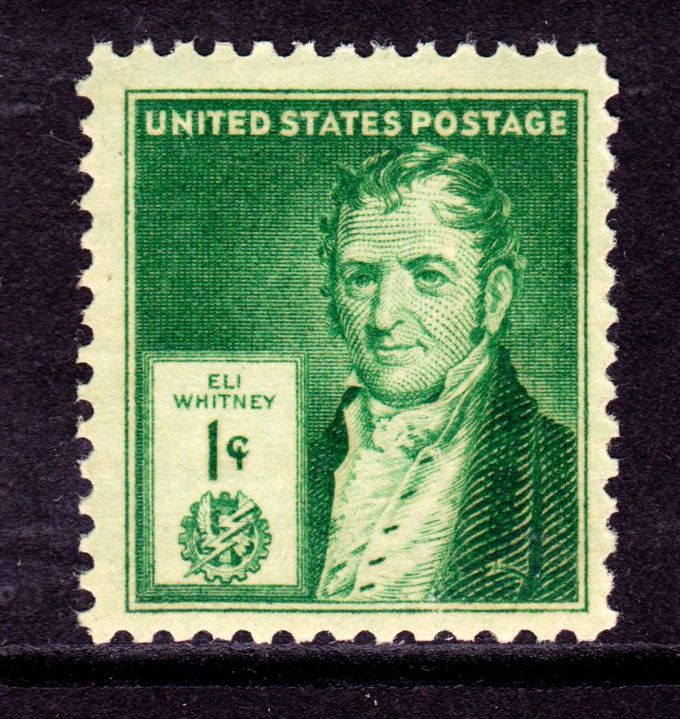
Eli Whitney on U.S. stamp result of 1940: Eli Whitney'south crucial contributions to the Market Revolution created a lasting legacy.
Advancements in the West
Many new products revolutionized agriculture in the Due west as well. John Deere, for example, invented a equus caballus-pulled steel plow to replace the difficult oxen-driven wooden plows that farmers had used for centuries. The steel plow allowed farmers to till soil faster and more cheaply without having to make repairs as often. In the 1830s, Cyrus McCormick's mechanical mower-reaper quintupled the efficiency of wheat farming. Only as southern farmers had prospered after the invention of the cotton gin, farmers in the West raked in huge profits as they conquered more lands from the American Indians to plant more and more than wheat. For the kickoff time, farmers began producing more wheat than the West could consume. Rather than permit information technology go to waste material, they began to transport crop surpluses to sell in the manufacturing Northeast.
The American System
The importance of the federal authorities also grew during this menstruation. Congressman Henry Dirt introduced the American System to develop internal improvements, protect U.Due south. industry through tariffs, and create a national banking concern. Federal and local governments, every bit well equally private individuals, invested in roads, canals, and railroads. The 1825 completion of the Erie Culvert was a tremendous engineering feat and opened the West for trade with markets on the e coast.
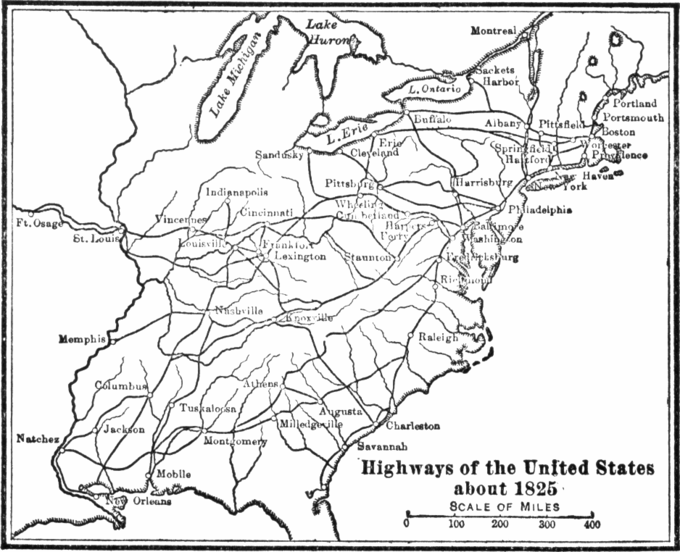
Highways of the U.s., ca. 1825: Turnpikes, canals, and rails lines drastically changed America's mural, first in the 1800s.
Following the War of 1812, the American economy was contradistinct from an economy partly dependent on imports from Europe to an empire of internal commerce. With a new generation of leaders, the Republican Party came to embrace the principles of government activism and the development of big-scale domestic manufacturing.
W invasion into American Indian territory relegated rich new farmlands to the United States. This catamenia of rapid development in the East and expansion in the West produced a wave of land speculation that resulted in economical periods of boom and bosom. These periods were characterized by patterns of loftier market prices followed past ruinously low prices, falling production, and bankruptcies past producers.
Transportation: Roads, Canals, and Railroads
In the nineteenth century, the construction of roads, rails, and canals dramatically improved national mobility.
Learning Objectives
Describe the revolution in transportation in the nineteenth century and its contribution to economic growth
Key Takeaways
Key Points
- During the first quarter of the nineteenth century, the federal government, country governments, and private investors directed meaning resources to the transportation sector.
- The National Road, or Cumberland Route, was the first highway built by the federal government.
- The development of the Erie Canal, extending from New York State to the Slap-up Lakes, cutting the costs of freight send past 95 percent and contributed greatly to the wealth and stature of New York City.
- Though canals offered tremendous advantages over land shipment, they could not compete with the efficiency and flexibility of the railroad.
- The most prominent early railroad was the Baltimore and Ohio Railroad (B&O), which linked the port of Baltimore to the Ohio River and offered passenger and freight service as of 1830.
- With improved methods of transportation came the concept of Manifest Destiny; land developers, railroad magnates, and other investors capitalized on west settlement into American Indian country.
Key Terms
- Erie Culvert: The 363 mile-long canal from the Great Lake of the aforementioned name to the Hudson River.
- Baltimore and Ohio Railroad: One of the oldest rails lines in the United States and the first common carrier rail line.
- National Route: The first major improved highway in the United States to exist congenital by the federal authorities.
Advances in Transportation
In the belatedly eighteenth century, the U.Due south. population was centered on the Atlantic coast, with all major population centers located on natural harbors or navigable waterways. Water and river transportation were central to the national economic system, while about overland transportation was past horse, which made it difficult to motion large quantities of appurtenances. By 1803, the state was growing chop-chop with the admission of Kentucky, Tennessee, and Ohio; yet, the only means of transportation between these landlocked western states and their coastal neighbors was by foot, pack animal, or send.
During the nineteenth century, transportation routes and means of send underwent dramatic changes, greatly increasing national mobility. New and improved transportation technology fabricated it easier and faster to transport goods: first national roads, and so canals, and finally the railroad revolution.
Roads
In eighteenth-century America, roads were privately built, and the government played little office in their construction. Early on toll roads were synthetic and owned past joint-stock companies that sold stock to raise construction uppercase. As the nation expanded, however, the government came to see the transportation network as a public good worthy of authorities support.
In 1808, a authorities-sponsored Written report on the Subject area of Public Roads and Canals suggested that the federal government should fund the structure of interstate turnpikes and canals. The suggestion was controversial: Anti-Federalists opposed expanding authorities power, but many others were persuaded by the compelling need for overland roads for armed services operations as well as for general commerce. Post-obit the report, piece of work began on a National Route to connect the west to the eastern seaboard. In 1815, structure on the National Road (also known as the "Cumberland Road") began in Cumberland, Maryland; by 1818, the road had reached Wheeling, Westward Virginia (then part of Virginia). Though political strife ultimately prevented its western advance to the Mississippi River, this route became the gateway for thousands of west-bound antebellum settlers.
Canals
In the belatedly eighteenth and early on nineteenth centuries, economic expansion spurred the edifice of canals to speed goods to market place. Among the most of import of these canals was the Erie Canal. First proposed in 1807, the Erie Culvert waterway was constructed from 1817 to 1825 and was the get-go transportation system between New York City and the western interior of the United States. Extending from Albany, New York, on the Hudson River to Buffalo, New York, the canal cut transport costs by most 95 percent.
The Erie Canal made an immense contribution to the wealth and importance of New York Urban center, which became the chief U.S. port, and it fostered a population surge in western New York Land. It also served to increase trade throughout the nation by opening eastern and overseas markets to midwestern farm products, and information technology opened regions further west to settlement. The success of the Erie Canal led to a proliferation of smaller culvert routes in the region.

Contour of the grand Erie Canal: This is an 1832 profile of the Erie Canal, connecting New York City to the Western Interior of the U.S.
The Illinois and Michigan Canal was built in 1848 to connect the Smashing Lakes to the Mississippi River and the Gulf of United mexican states. It helped plant Chicago equally the transportation hub of the United States. About of the culvert work was done past Irish immigrants who had previously worked on the Erie Culvert. Towns were planned out forth the path of the culvert, spaced at intervals corresponding to the length that the mules could haul the barges. From 1848 to 1852, the canal was a popular passenger road, only this ended in 1853 with the opening of the Chicago, Rock Island, and Pacific Railroad that ran parallel to the culvert. Today, much of the canal is a long, thin park with canoeing and a 62.v-mile hiking and biking trail (constructed on the alignment of the mule tow paths).

Locktender's House on the Illinois and Michigan Canal: Lock No. viii and Locktender's House, Illinois and Michigan Culvert simply west of Aux Sable Creek, near Morris, Illinois. The Illinois and Michigan Canal was an important canal in the nineteenth century, merely was rendered obsolete when new railroads replaced information technology.
Railroads
Canals radically improved transportation, only their reign was short-lived. By the mid-nineteenth century, the culvert nail was brought to a sudden end by the rapid expansion of railroads. Railroads provided a quick, scheduled, and year-round mode of transportation. Railroads were superior to water routes in that they provided a safer, less hazardous mode of transport.
Beginning in 1826, several states chartered railroads, including Massachusetts, New York, Southward Carolina, and Pennsylvania. The about prominent early railroad was the Baltimore and Ohio Railroad (B&O), which linked the port of Baltimore to the Ohio River and offered passenger and freight service as of 1830.
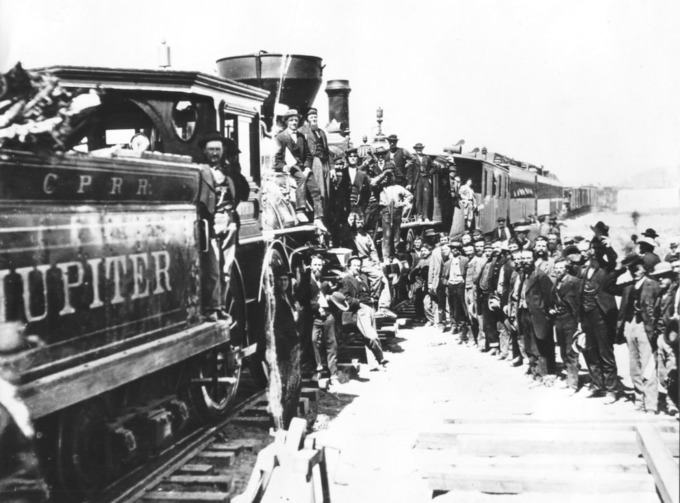
Celebration of completion of the Transcontinental Railroad on May 10, 1869: Railroads came to play a major role in westward expansion in the late nineteenth century.
Effect on American Indians
Improved transportation increased the United States' potential to expand its borders w. While much of the basis for west expansion was economic, in that location was also some other reason, which was bound up in the American belief that the state, and the American Indian "heathens" who populated it, were destined to come under the civilizing dominion of Euro-American settlers and their superior engineering science, almost notably railroads and the telegraph. While it's unclear whether that conventionalities was a heartfelt motivation held by most Americans or simply a rationalization of the conquests that followed, the clashes—both physical and cultural—that resulted from this western migration left scars on the country that still are felt today.
The concept of "Manifest Destiny" institute its roots in the long-standing traditions of territorial expansion upon which the nation itself was founded. Land developers, railroad magnates, and other investors capitalized on westward settlement into American Indian land. The Pacific Railway Act of 1862 was pivotal in helping settlers move westward more apace. Other railway initiatives would follow, afterward creating a network linking all corners of the nation.
Factories, Working Women, and Wage Labor
Industrialization in the United States was marked past a growth in factories and an implementation of wage labor, too equally by an increase in the number of working women and deskilled workers.
Learning Objectives
Describe the early on years of industrialization in the American Northeast
Key Takeaways
Key Points
- Beginning with the cloth industry, wage labor began to replace family labor and apprenticeship every bit the dominant form of labor in the United states of america.
- Francis Cabot Lowell's Boston Manufacturing Visitor popularized reliance on wage labor, which involves a laborer selling his or her labor to an employer under contract. The Boston Manufacturing Visitor became the leading textile manufacturer in the United States and pioneered the Waltham-Lowell System.
- Young women were the primary labor force in the textile industry, though children often were employed in mills, too.
- In the 1830s, the Lowell Manufacturing plant Girls organized strikes to protestation wage reductions; these women were some of the primeval examples of labor- reform movements.
Key Terms
- Deskilling: The process by which skilled labor within an industry or economy is eliminated by the introduction of technologies operated by semiskilled or unskilled workers.
- wage labor: The socioeconomic relationship betwixt a worker and an employer, in which the worker sells his or her labor under a formal or informal employment contract.
- Waltham-Lowell System: A labor and product model employed in the U.s., especially in New England, during the early years of the American cloth manufacture in the early nineteenth century.
Industrialization in the Northeast
Equally the nation deepened its technological base, artisans and craftsmen were made obsolete through the process of deskilling, equally they were replaced by non-specialized workers. These workers used machines to replicate in minutes or hours work that would crave a skilled worker days to consummate. Every bit New England 'south cloth industry took off, mill villages apace grew into large factory towns, alluring rural workers from the surrounding countryside. The many children employed in early factories were paid very depression wages because they were seen to exist supplementing family income.
The Rise of the Textile Industry
At the showtime of the Industrial Revolution, the cloth industry was rife with potential for mechanization. Prior to this menses, cloth production was traditionally performed at dwelling; however, at the beginning of the nineteenth century, the work was mechanized and increasingly done on an industrial scale.
Slater's Mill
In the late eighteenth century, the English textile industry had adopted technological innovations that greatly improved the efficiency and quality of textile manufacture: the spinning jenny, water frame, and spinning mule. However, these technologies were closely guarded past the British government. In 1789, Samuel Slater, an apprentice in one of the largest textile factories in England, defied British laws confronting the emigration of skilled laborers and smuggled his cognition of fabric mechanism to the United States. In 1793, he established a cotton wool-spinning factory with a fully mechanized water-power system at the Slater Factory in Pawtucket, Rhode Island. Slater's Factory was established in the Blackstone Valley, which became one of the primeval industrialized regions in the United States. At its peak, more than than ane,000 mills operated in this valley. Slater went on to build several more cotton and wool mills throughout New England.
Lowell's Factories
Slater's mills ran on a business organisation model called the "Rhode Isle Organization." In this model, manufacturing plant villages employed all members of a family. By the 1820s, this arrangement began to be replaced by a more than efficient system based upon the ideas of Francis Cabot Lowell, an American businessman who was instrumental in bringing the Industrial Revolution to the United States. Lowell's Boston Manufacturing Company dominated the textile industry in the United States in the 1820s, developing efficient and novel systems of labor and production.
Lowell, a Massachusetts merchant, was permitted to tour British textile factories in 1810. He memorized the blueprint of cloth machines, and on his return to the United states of america, he established the Boston Manufacturing Visitor. In the "Waltham-Lowell System," for the start fourth dimension, both spinning and weaving occurred on site, and mill workers resided in collective company housing under strict supervision. Following his death in 1817, Lowell's associates built America'due south kickoff planned factory town: the eponymous Lowell, Massachusetts.

"Lowell Mill Girls," ca. 1870: 2 women factory workers known equally "Lowell Factory Girls."
Wage Labor and Mill Atmospheric condition
Lowell popularized the use of the wage labor, a system in which a worker sells his or her labor to an employer nether contract. Wage labor displaced reliance on apprenticeship and family labor. Jeffersonian agrarians viewed wage labor as a negative force in gild, arguing that the economy of the United States should be built upon agriculture rather than on industry. Jefferson reasoned that the growth of a class of wage laborers would decrease self-sufficiency in America.
Lowell's factory employed young female workers, some as young every bit ten years erstwhile. These workers were typically hired for contracts of one year. Though considered an comeback on the squalid conditions of factory towns in the Uk, weather condition in the Lowell mills were severe by modern American standards. Factories were crowded and extremely loud with poor air quality and little to no ventilation. Employees worked from 5:00 a.m. until seven:00 p.m., for every bit many as 80 hours per calendar week. This model became known as the "Waltham-Lowell System."
The monotony of repetitive tasks made days specially long. In the winter, when the sun prepare early, oil lamps were used to light the factory floor, and employees strained their optics to see their work and coughed equally the rooms filled with smoke from the lamps. Some factories did not permit employees to sit down. Doors and windows were kept closed, especially in textile factories where fibers could be easily disturbed by incoming breezes, and mills were often unbearably hot and humid in the summertime. In the winter, workers often shivered in the cold. In such environments, workers' wellness suffered.
The workplace posed other dangers every bit well. The presence of cotton wool bales alongside the oil used to lubricate machines made burn a common problem in textile factories. Workplace injuries were also common. Workers' hands and fingers were maimed or severed when they were caught in machines; in some cases, limbs or unabridged bodies were crushed. Workers who didn't dice from such injuries almost certainly lost their jobs, and with them, their income. Corporal punishment of both children and adults was mutual in factories; where corruption was most extreme, children sometimes died as a result of injuries suffered at the easily of an overseer.
As the decades passed, working conditions deteriorated in many mills. Workers were assigned more than machines to tend, and the owners increased the speed at which the machines operated. Wages were cut in many factories, and employees who had once labored for an hourly wage at present constitute themselves reduced to piecework, paid for the amount they produced and not for the hours they toiled. Owners also reduced bounty for piecework. Depression wages combined with regular periods of unemployment fabricated the lives of workers difficult, particularly for those individuals with families to support. In New York City in 1850, for example, the average male person worker earned $300 a year; it cost approximately $600 a year to support a family of five.
Early on Labor Reform Movements
The long hours, strict subject field, and depression wages presently led workers to organize to protest their working conditions and pay. In 1821, the young women employed by the Boston Manufacturing Company in Waltham went on strike for ii days when their wages were cut. In 1824, workers in Pawtucket went on strike to protest reduced pay rates and longer hours, the latter of which had been accomplished by cutting back the amount of time allowed for meals. Similar strikes occurred at Lowell and in other mill towns such equally Dover, New Hampshire, where the women employed by the Cocheco Manufacturing Company ceased working in December 1828 after their wages were reduced.
In the 1830s, female mill operatives in Lowell formed the Lowell Manufactory Girls Clan to organize strike activities in the face up of wage cuts and, later, established the Lowell Female Labor Reform Association to protestation the twelve-hour workday. They distributed legislative petitions, formed labor organizations, contributed essays and articles to pro-labor newspapers, and protested through turn-outs or strikes. Even though strikes were rarely successful and workers unremarkably were forced to take reduced wages and increased hours, work stoppages as a form of labor protestation represented the beginnings of the labor movement in the United States.
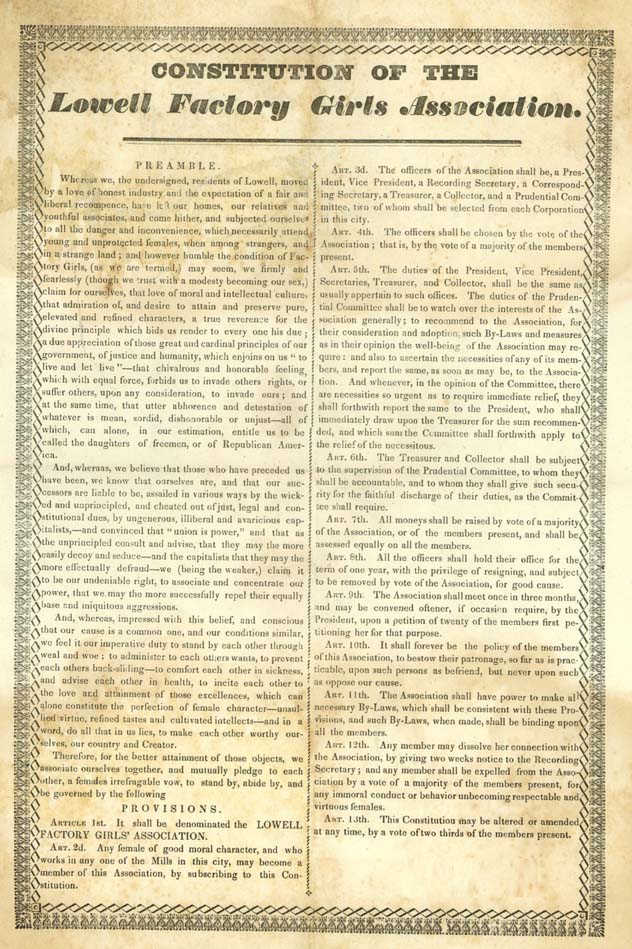
Constitution of the Factory Girls Association in Lowell, Massachusetts, 1836: This is the constitution of the Labor Reform Clan of Lowell's female material workers, drafted in 1836.
The Growth of the Cotton Manufacture
Eli Whitney'south invention of the cotton wool gin in 1793 resulted in massive growth in the cotton industry in the American South.
Learning Objectives
Draw the economic and political furnishings of Eli Whitney's cotton gin
Cardinal Takeaways
Key Points
- With the invention of Eli Whitney 's cotton gin in 1793, cotton became a tremendously profitable industry, creating many fortunes for white plantation owners in the antebellum S.
- The cotton gin (short for "cotton fiber engine") was a automobile that quickly and easily separated cotton wool fibers from their seeds, a job that otherwise had to be performed painstakingly by hand, most oft by slaves.
- Cotton before long became the primary export in the Us and by 1860, on the eve of the Civil State of war, the southern states were providing two-thirds of the world's supply of cotton.
- The textile boom in New England created an important domestic market place for cotton wool producers. Cotton fiber plantations depended on slave labor, and as a upshot of the boom in this industry, slavery increased dramatically in the early nineteenth century.
- Due to its profound effect on American slavery, the growth of the cotton fiber industry is oft cited as i of the causes of the American Civil War.
Fundamental Terms
- Eli Whitney: An American inventor all-time known for inventing the cotton gin.
- cotton gin: A motorcar that quickly and easily separates cotton fibers from their seeds, a task that otherwise must be performed painstakingly past mitt.
Cotton wool in the S
In the antebellum era—that is, in the years earlier the Civil War—American planters in the South continued to abound Chesapeake tobacco and Carolina rice as they had in the colonial era. Cotton fiber, however, emerged as the antebellum South'south major commercial crop, eclipsing tobacco, rice, and saccharide in economic importance.
The Cotton Gin
In 1793, Eli Whitney revolutionized the production of cotton when he invented the cotton wool gin, a device that separated the seeds from raw cotton fiber. Suddenly, a process that was extraordinarily labor-intensive when done by hand could be completed quickly and easily. The cotton gin (short for "cotton engine") quickly and easily separated cotton fibers from their seeds, a job that otherwise had to be performed painstakingly past hand—most often by slaves. Whitney's introduction of "teeth" in his cotton gin to comb out the cotton wool and separate the seeds revolutionized this process.
With the invention of Whitney's cotton gin, cotton became a tremendously assisting manufacture, creating many fortunes in the antebellum South. American plantation owners, who were searching for a successful staple crop to compete on the earth market, found it in cotton.

A cotton wool gin on brandish at the Eli Whitney Museum: The invention of the cotton gin revolutionized the textile manufacture in the early nineteenth century and transformed the economy of the South.
Domestic and International Markets
Every bit a commodity, cotton wool had the advantage of beingness easily stored and transported. A demand for information technology already existed in the industrial material mills in U.k., and in time, a steady stream of slave-grown American cotton would also supply northern cloth mills. Southern cotton, picked and processed past American slaves, helped fuel the nineteenth-century Industrial Revolution in both the Usa and Bully Britain.
New Orleans, Louisiana, and Galveston, Texas, were shipping points that derived substantial economic benefit from cotton raised throughout the South. Cotton wool soon became the principal consign in the United States, and by 1860, on the eve of the Civil State of war, the southern states were providing two-thirds of the world's supply of cotton.
Additionally, the development of large-scale mills and metal motorcar tools dramatically increased textile production in northern mill towns in the early 1800s. Though cotton wool was primarily grown for export to Europe, this fabric boom in New England created an important domestic market for southern cotton fiber producers.
Cotton wool, Slavery, and the Civil War
Due to its profound consequence on American slavery, the growth of the cotton wool industry is frequently cited as one of the causes of the American Civil War. The number of slaves rose in concert with the increase in cotton wool product, increasing from approximately 700,000 in 1790 to roughly 3.2 million in 1850. A congressional ban on the importation of slaves from Africa in 1808 only increased the demand for domestic slaves on cotton plantations, hindering the work of abolitionists who sought to end slavery. The domestic slave trade exploded, providing economic opportunities for whites involved in many aspects of the trade and increasing the possibility of slaves' dislocation and separation from kin and friends.
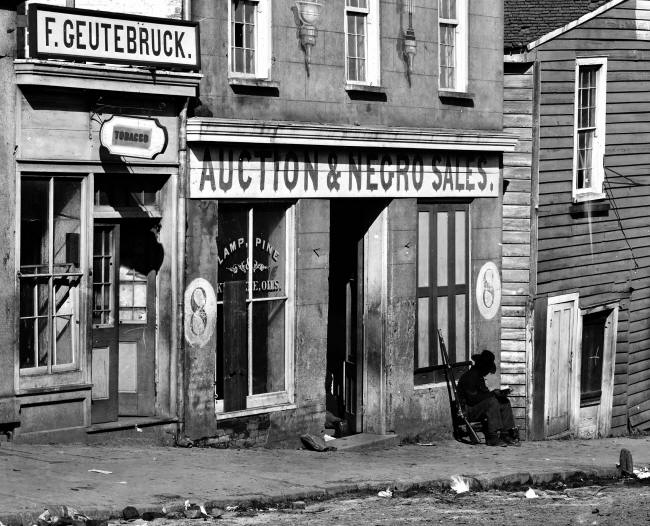
Slave market in Atlanta, Georgia, 1864: This image depicts the site of a slave market in Atlanta in 1864. The cotton industry in the Southward was fully dependent on the institution of slavery.
A Communications Revolution
The United States experienced a communication revolution in in the early 1800s, during which the penny printing and the electrical telegraph emerged.
Learning Objectives
Identify 2 central components in the nineteenth century's communications revolution
Cardinal Takeaways
Central Points
- Prior to the development of the penny press, newspapers primarily serviced the business customs and served as tools for political propaganda.
- In 1833, the first penny paper, the Sun, was founded in New York. Penny papers were the beginning papers to target working and eye class audiences.
- While most newspapers were controlled past political parties and reported a party line, penny papers, known for their sensational journalism, were politically independent. In 1836, Samuel Morse and Alfred Vail invented the electrical telegraph and the Morse code signaling alphabet, allowing for the wired communication of letters using electrical signals.
- Improved communication systems fostered the development of business organisation, economics, and politics by allowing for dissemination of news at a speed previously unknown.
Key Terms
- Electrical Telegraph: A type of advice that uses electrical signals, normally conveyed via telecommunications lines or radio.
Advances in forms of communications greatly expanded in the U.s.a. during the early 1800s. The penny printing and the electrical telegraph were amid the innovations that emerged during this communications revolution.
Newspapers
In the early on 1800s, newspapers were largely meant for the elite. They generally took two forms: mercantile sheets intended for the business customs, which contained ship schedules, wholesale production prices, advertisements, and some foreign news; and political newspapers, which were controlled by political parties or their editors as a ways of sharing their views with aristocracy stakeholders. Journalists reported the party line and editorialized in favor of party positions.
Mass production of cheap newspapers became possible due to the shift from handcrafted printing to steam-powered printing. In 1833, the first "penny paper," the Sun, was founded in New York. Penny papers—specifically targeting the working course urban population—quickly became widespread. The cheap sensationalized news sources covered law-breaking, tragedy, run a risk, and gossip, and these newspapers easily shifted fidelity on political problems. The changes fabricated during the Penny Press era prepare the standards for all future newspapers, and those standards are nevertheless implemented today.
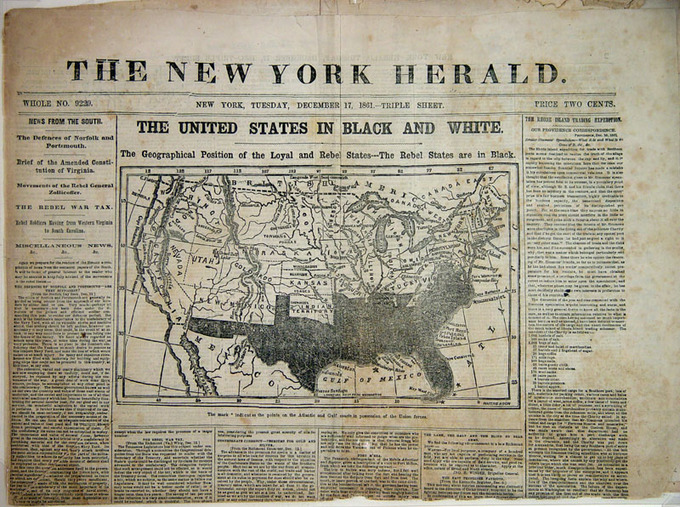
The New York Herald Penny Press, 1861: The penny press revolutionized journalism in the 1830s.
Electric Telegraph
In 1836, Samuel Morse and Alfred Vail developed an electric telegraph capable of transmitting text messages over long distances using wire. Together, they developed the Morse lawmaking signaling alphabet system.
In 1843, the U.S. Congress appropriated $thirty,000 to fund an experimental telegraph line from Washington, D.C., to Baltimore, Maryland. In May of 1844, Morse made the first public demonstration of his telegraph, sending the famous message, "What hath God wrought?" The Morse-Vail telegraph was quickly deployed in the following two decades. Improved advice systems fostered the evolution of business, economic science, and politics by allowing for broadcasting of news at a speed previously unknown.
Licenses and Attributions
Source: https://courses.lumenlearning.com/boundless-ushistory/chapter/the-market-revolution/
Posted by: reynoldslefor1982.blogspot.com

0 Response to "What Changes Were Linked To The Rise Of The Market Economy?"
Post a Comment